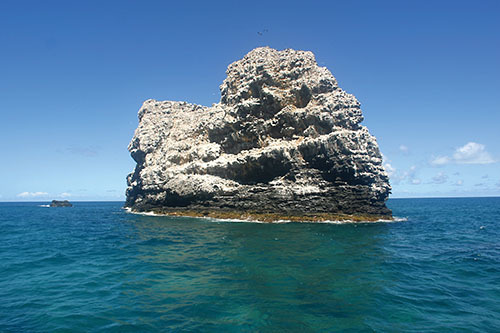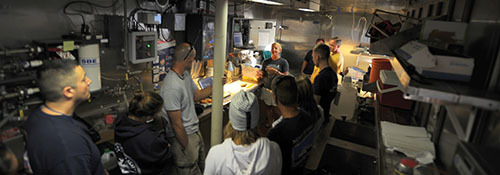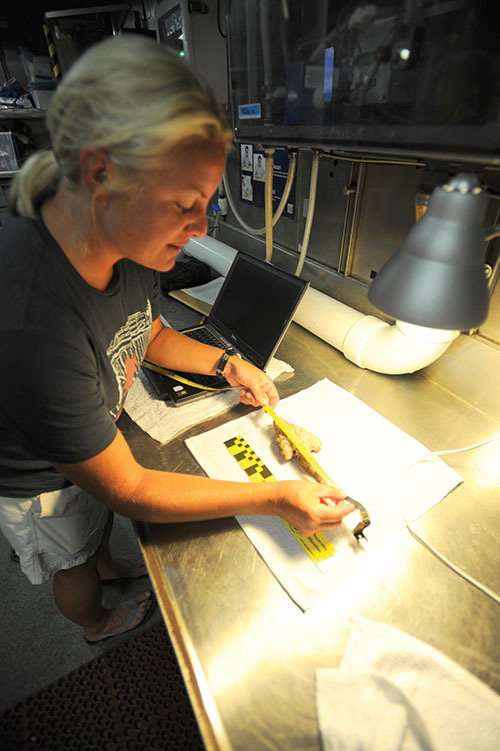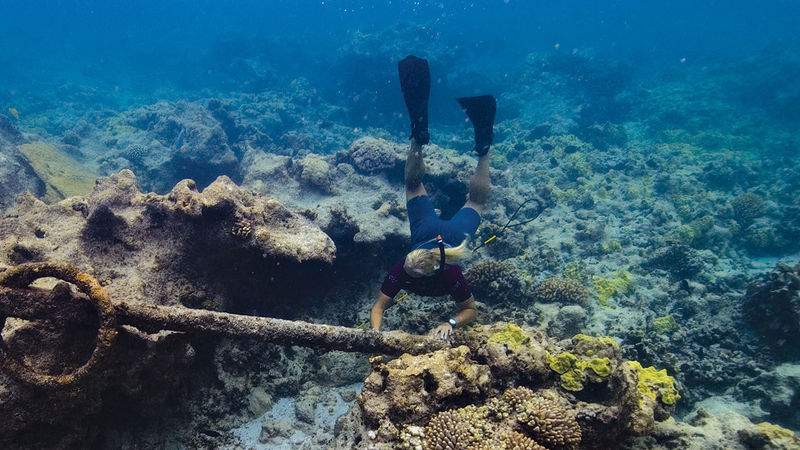In the summer of 1852, the novelist Herman Melville arranged to meet a night watchman living on Nantucket Island off Cape Cod. The 32-year-old writer sought out George Pollard Jr. because he felt a debt of gratitude to the old man.
Melville’s most recent novel, which he described as “a romance of adventure based on certain wild legends of the southern sperm whale fisheries,” had been published the year before. He was pleased to finally meet the man who some 30 years earlier had lived the wild legend on which Moby-Dick was based.
Pollard’s story, in fact, was even wilder than Melville’s fiction. As a young sea captain, he had commanded the whaling ship Essex, which sank after being rammed twice by a sperm whale. The 29-year-old shipmaster and his crew were cast adrift in the Pacific for three months, eventually resorting to cannibalism before their rescue.
The visit with Pollard made a deep impression on the young writer. Of their meeting, Melville later wrote, “To the islanders he was a nobody — to me, the most impressive man, tho’ wholly unassuming, even humble — that I ever encountered.”
Having served on whaling ships in his 20s, Melville understood how the Nantucket captain had been marked a “Jonah,” a sailor shunned because he was perpetually dogged by misfortune. As horrific as the Essex experience had been, it was not, the novelist knew, Pollard’s last maritime tragedy. There had been yet one more disastrous chapter.
And Kelly Gleason ’98 would write the final details.
In the brilliant noonday sun of August 23, 2008, a 30-foot-long, bright orange boat gurgled slowly across the undulating lagoon at French Frigate Shoals, a Pacific atoll about 600 miles northwest of Honolulu. The sky held only a few puffy clouds, tinged a soft green from the reflected lagoon. In the distance, a few miles to the south, a 120-foot-high volcanic rock named LaPerouse Pinnacle reared up from the water, looking very much like a French frigate in full sail.

The 20-mile-long, crescent-shaped reef is part of the Hawaiian archipelago and has been a hazard for shipping ever since the French explorer Jean Francois LaPerouse discovered it by nearly running aground there on the night of November 6, 1786. Since then, at least three 19th century sailing ships had broken up on the coral and lie somewhere nearby on the ocean floor. On this day Kelly Gleason and her six-member team were looking for any sign of those and other sunken ships.
Among her duties, Gleason, a maritime archaeologist working for the National Oceanic and Atmospheric Administration (NOAA), is charged with finding “cultural resources” in the Papahanaumokuakea Marine National Monument, a vast 1,200-mile-long federally protected marine sanctuary in the Northwest Hawaiian Islands. The conservation area, which stretches from northwest of Hawaii’s Kauai Island to the Kure Atoll, was established in 2006 by presidential proclamation and designated a UNESCO World Heritage Site in 2010.
Along with marine biologists studying wildlife, Gleason heads out once or twice a year on the 224-foot NOAA research vessel Hi’ialakai to search for sunken ships and aircraft. Typically the cruises last up to a month and include visits to several atolls in the Northwest Hawaiian Islands, where many ships went down and planes crashed during World War II.
- Related articles
- Collision Course
- Lightning Strikes Twice
As far as the archaeologist was concerned, the 2008 cruise had already been hugely successful. Most of the time had been spent at Kure Atoll near Midway Island, a five-day journey from Honolulu. Gleason was euphoric because, while at Kure, her team had located the wreckage of a British whaling ship, the Gledstanes, which had sunk in 1837.

On the way back home to Pearl Harbor, the scientists decided to stop for a few days at French Frigate Shoals, an atoll uninhabited except for a few biologists stationed on Tern Island, the largest of 12 tiny spits of sand euphemistically designated “islands” in the atoll’s lagoon.
Having completed her scheduled work and, with a day-and-a-half to burn before returning home, Gleason decided to search an unexplored section of the lagoon that had often been used as an anchorage by guano mining ships. “We weren’t expecting much. If we were lucky, we thought we might find a random artifact that had been tossed overboard.”
As the jet boat launched from the Hi’ialakai slowly trolled the shallow waters near Shark Island at the northwest edge of the shoals, Gleason and Jason Raupp, an Australian maritime archaeology doctoral student, jumped into the water. Wearing snorkel masks and flippers, and looking like downed water skiers clutching tow boards, the divers were slowly pulled through the lagoon by the jet boat.
Periodically, the swimmers angled their boards down, plunging beneath the surface. When they needed another breath, they’d angle up, rising and falling as the boat dragged them through the water. All the while they peered through pastel green-tinted water and rainbow-colored schools of fish, 15 feet to the bottom, scanning methodically for the encrusted remains of a ship.
It’s one of the tedious but necessary tasks of maritime archaeology: Before you can explore a shipwreck, you must find it. Unfortunately, a 19th century shipwreck looks nothing like Captain Jack Sparrow’s wreck in Disney’s Pirates of the Caribbean.
There are no recognizable masts or hulls on the sea floor. Surging warm sea water disintegrates a wooden vessel in no time. What remains is scattered, calcium-encrusted, brownish-rose colored rubble that, unfortunately for people like Gleason and Raupp, blends in all too well with the surroundings.
High-tech devices such as magnetometers, which detect metal, are useful, but Gleason says the human eye remains one of the most sensitive sensors of all, and a low-tech snorkeler peering into the depths is still one of the best ways to find a shipwreck.
As Gleason recalls, they had been in the water barely 15 minutes when Raupp released his tow board, allowing it to bob to the surface, the signal to those on the jet boat that he had spotted something. By the time the craft circled back to the divers, Gleason had already joined her partner. Sure enough, amid the vegetation and coral, they recognized the unmistakable outline of a 10-foot-long anchor poking from the lagoon floor.
The find was intriguing but not necessarily a sign of anything more. Its design suggested an early 19th century ship. However, it could have been a stray anchor that had somehow come to rest there. The question: Was more related debris nearby?
The answer came quickly. A few minutes after the duo resumed tow boarding, they found a gigantic cast iron cauldron, about 9 feet in diameter, lying on its side in the sand.
The cauldron meant two exciting things: First, the divers definitely were looking at a shipwreck site. Second, it was a whaling ship. They recognized the cauldron as a “try pot,” a large vat used on board ship to boil down slabs of whale blubber, rendering it into whale oil, the valuable 19th century commodity employed in everything from soap and perfume to lamps and lubrication.
The try pot was an essential piece of whaling equipment and would not have been randomly tossed overboard. “This had to be the remains of a shipwreck,” Gleason says. “A whaling ship would not have been in 15 feet of water on purpose. It had to have been there by accident.”
Soon the rest of the jet boat team donned snorkel masks and flippers, and joined the exploration party. Armed with cameras and underwater slates to take notes, two-person teams fanned across a football field-sized debris area.
By 5 p.m. when the team returned to the Hi’ialakai mother ship for dinner, they had found two more try pots, another anchor and hundreds of bricks, which were used to protect a whaling ship’s deck from the heat of rendering blubber into oil.
The next day, Gleason and her crew returned to the Shark Island site in scuba gear. With the freedom to spend extended time underwater, they created a shipwreck site map by taking measurements and recording angles between the discovered artifacts.

From previous archival research, Gleason knew there were three possibilities for the identity of the “Shark Island Mystery Whaler,” as they were calling it. The wreck might be the Daniel Wood, which ran aground in 1867; the South Seaman, lost in 1859; or the Two Brothers, which broke up on the reef in 1823.
Of all the possibilities, the most intriguing was the Two Brothers, Captain George Pollard’s last command. If, in fact, the wreck turned out to be Pollard’s, Gleason knew it would garner intense public interest because of the Nantucket captain’s association with Moby-Dick and his real-life Essex exploits. The Essex story had been made famous in several best-sellers over the years, beginning with one written by Pollard’s first mate, Owen Chase, in 1821 and, most recently, Nathaniel Philbrick’s 2000 In the Heart of the Sea.
Less well known has been the story of the Two Brothers, the tragic coda to Pollard’s sailing career. On the night of February 11, 1823, during a fierce storm, the Two Brothers ran aground on the reef and broke apart. Should this truly be Pollard’s wreck, Gleason was anxious to fill in the details. The team, however, had barely scratched the surface of the shipwreck, and nothing they had found definitively identified the ship’s remains. And now they had to leave the site.
If asked, Gleason would likely admit that the most excruciating aspect of her job is that she has limited time at sea, and her trips must be coordinated with the research needs and interests of other NOAA scientists. In practice that means if the schedule says the Hi’ialakai is due back at Pearl Harbor, the field work gets dropped until the next site visit. And that visit may be a year later.
Like it or not, Gleason had a year to wonder about the wreck at French Frigate Shoals. Fortunately, the picture came more into focus that next year. Although she had only one day at Shark Island in 2009, it was time well spent. The archaeologist found the stern section of the wreck about 200 yards from the original site. “The debris field is widely scattered because, as the ship broke up, parts of it floated away before they sank,” Gleason explains.
The new debris field proved to be a treasure trove of artifacts, including ceramics, glass and strange, miniature try pots. Most significantly, however, Gleason found the first-ever harpoon tip at a whaling shipwreck.
This was Huge, with a capital H. Not only was it the first such discovery ever recorded, but Gleason knew it could be the evidence they needed to positively identify the shipwreck. “Typically, whaling ships would etch their name into a harpoon tip as a way of laying claim to a whale should it get away and be brought in by another ship,” she says.
But there were two problems. In order to determine if it was engraved, the harpoon would have to be removed from the site and X-rayed to see how much metal remained inside the crust. If enough metal was available, the calcium could then be carefully removed by someone trained in artifact conservation. All that, of course, would require taking the harpoon tip from the site.
Which led to the second problem: Removing an artifact from the Papahanauomukuakea National Monument requires a specific permit, which Gleason did not then have.
Playing by the rules, she put the harpoon back at the site, took a boatload of pictures and crossed her fingers that it would be there next year. Miraculously, when Gleason returned in 2010, the harpoon tip was precisely where she had placed it.
The miracle, unfortunately, did not extend to the weapon’s restoration. When the conservator removed the calcium crust, no ship’s name was visible. Years of undersea buffeting had apparently smoothed away the etching.
As things turned out, however, it didn’t matter. In the off-season, between expeditions, Gleason traveled to the Library of Congress and to museums in Massachusetts and Connecticut to learn everything she could about the Two Brothers and what it might have been carrying when it went down.
From her fieldwork, the archaeologist had documented more than 100 artifacts at the site. These included china and glass fragments; pieces of the ship’s rigging; blubber hooks, used to hoist strips of whale fat cut from the carcass; the glass from the ship’s chronometer, employed by the captain to navigate; a grinding wheel; and the earlier finds of the anchor, harpoon tip, try pots and bricks. Her archival work confirmed all of it was consistent with an early 19th century whaling ship.
Best of all, an 1816 newspaper advertisement Gleason unearthed in the Nantucket Historical Association archives strongly linked the wreck to Nantucket in the early 19th century. The newspaper item detailed a distinctive type of cook pot sold then to Nantucket whaling ships. The archaeologist immediately recognized the pot in the ad as identical to the mysterious, miniature try pots her team had found and wondered about. The evidence pointing to the Two Brothers may have been circumstantial, but it was overwhelming.
Gleason’s superiors were so confident in her case that on February 11, 2011, the 188th anniversary of the wreck of the Two Brothers, NOAA’s Office of National Marine Sanctuaries held a press conference announcing the discovery.
All along Gleason understood that the Two Brothers discovery was a big deal, but she was stunned by the intensity of worldwide press interest. With stories running on the major TV networks, in The New York Times, The Boston Globe and virtually every other major U.S. newspaper, an estimated 25 million people learned of the discovery.
In 2012, a Two Brothers museum exhibit developed by Gleason opened at the Nantucket Historical Association’s Whaling Museum. The exhibit, which will tour other New England museums and eventually arrive in Hawaii, tells the tale of Captain Pollard’s last whaling voyage and features several recovered artifacts. A documentary film about the Two Brothers shipwreck, Lightning Strikes Twice, is slated for release this fall.
For Gleason, working on the Two Brothers shipwreck has been an especially moving experience. The NOAA archaeologist sees her work as redeeming Captain Pollard’s legacy. His story is no longer merely a notorious bad-luck tale. Sparked by the shipwreck discovery, the re-telling of his tragedy offers the public a new window on whaling culture, she argues. It presents fresh insight into a largely forgotten time in American history when people risked their lives, traveling halfway around the world to bring back a precious substance.
“The poignant thing,” she says, “is that after losing his second ship we know [Pollard] makes it back to Nantucket but will never again be a whaling captain, the top of Nantucket’s social order. Instead, he lives out his life as a night watchman, one of the lowliest jobs on the island. And yet, he has given us this incredible glimpse into life on a 19th century whaling ship.
“There’s something emotional about being able to bring these artifacts back to Nantucket,” the maritime archaeologist confesses. “It puts an end on this epic story, some closure.”
An ending Kelly Gleason is humbled to provide.
John Monczunski, a freelance writer, was for many years an associate editor of this magazine.
